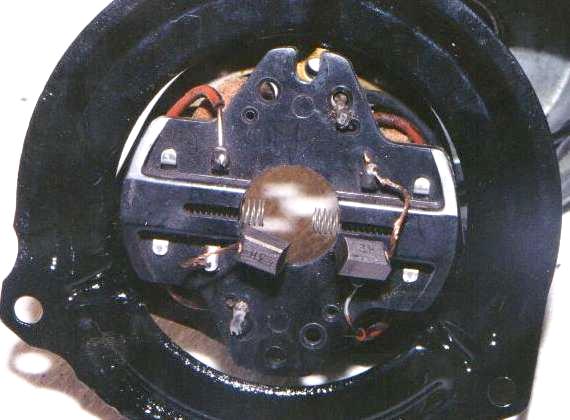The MGA With An Attitude
HEATER MOTOR TECH - ET-212 - Pg 5 of 7
For all of this time the brush carrier plate has been hanging around in the same place, supported only by the wires from the field coils. Here you see new carbon electrical brushes with the connecting wires soldered in place on the carrier contact strips. The electrical brushes may generally be purchased for minimal cost at a local hardware store. Also notice the small coil compression springs that fit in the carrier to back up the brushes. These springs are not particularly strong, but when free they should extend well out of the carrier as shown, and be lively and springy. Springs which are very soft, broken, kinked, or permanently compressed should be replaced. These can usually be found (also for very little cost) in the same store as the brushes.

Now for a few words on the wiring circuit. The MGA heater motor (as original) is a series wound direct current motor with two field coils. If you look carefully you can see all of the wire connections in the picture above, as all of the wires terminate on the plastic brush carrier plate (with metal contacts of course). Starting at the top of the picture, one black lead wire connects to a red wire for the coil on the right. The return wire from that coil connects to a tab on the plate at the lower right which is electrically connected to the right brush. The left brush is electrically connected to the red wire at the upper left, which goes to the field coil on the left. The return wire from that coil comes back to the bottom of the picture to connect to the other black power lead wire.
When power is on, electrical current flows in one black wire, through one field coil, then through the armature, and then through the second field coil, and finally back out the other black lead wire (all in series, which is where the motor type gets its name). Changing the polarity of the input power changes the polarity of all of the magnetic fields in this motor at the same time, so the motor would continue to run in the same direction. You cannot reverse the rotation of the motor by swapping the power leads, so both of the lead wires are black, because polarity doesn't matter.
Now consider that the MGA Twin Cam model has a reverse image heater box from the other MGA models, so for the Twin Cam heater the blower motor has to run in the opposite direction. Also consider that the MGA heater motor mounts at the back of the heater box next to the firewall, and the MGB heater is arranged so its blower motor mounts into the front of the heater box. As such, the MGB motor must rotate opposite the standard MGA motor, similar to the Twin Cam heater motor. These motors are physically interchangeable as long as you get the direction of rotation right. Changing that direction is done by swapping the wires of each field coil where they attach to the brush carrier plate, in effect reversing the magnetic polarity of the field coils in relation to the magnetic field of the armature. If you get both of the field coils connected in the wrong polarity the motor runs in the opposite direction. If you get only one of them wrong the motor will not run.
Later model MGB heater motors, and most of the new replacement motors currently available, are wired differently than illustrated here, and will in fact reverse direction of rotation simply by swapping the power leads. As such, those motors will have color coded power leads, and no internal tinkering is necessary to reverse the rotation. You should pay close attention to the direction of rotation of the motor, as the squirrel cage fan will move much more air when running in the correct direction. The wheel should turn in the direction that the outside edges of the blades are pointing, so that the fan throws the air forward as it rotates, not just outward.
|
